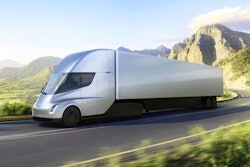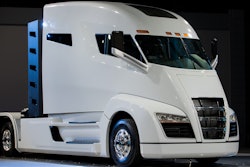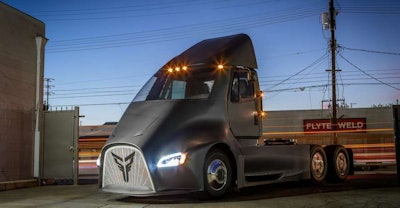 Thor’s ET-One tractor is powered by swappable battery packs. The company is targeting the short- and medium-haul segments, it says.
Thor’s ET-One tractor is powered by swappable battery packs. The company is targeting the short- and medium-haul segments, it says.Another upstart aiming to enter the trucking industry as an electric vehicle maker has introduced a battery-powered tractor that it says could come to market as soon as 2019.
Dakota Semler and Gio Sordoni cofounded their Los Angeles-based electric truck startup, Thor Trucks, in 2016 and hope to have their ET-One electric tractor available for sale by 2019. Semler and Sordoni call the electric truck the “Holy Grail of transportation.”
Powered by up to 800 kWh modular (swappable) battery packs, the company says its ET-One prototype features a 300 mile range when fully loaded to 80,000 pounds, and the TM4 motor – a motor used in a variety of heavy duty applications, including buses – puts out a massive a 5,000 lb. ft. torque that can be customized based on need.
All that power, the company says, comes with a base price of $150,000.
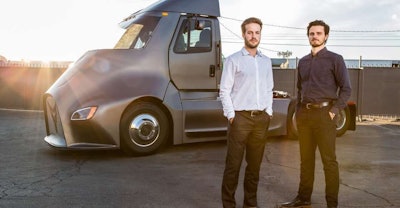 Founders Dakota Semler and Gio Sordoni say the design of Thor’s battery pack is unique in layout and cooling among those offered by other electric truck makers, like Tesla.
Founders Dakota Semler and Gio Sordoni say the design of Thor’s battery pack is unique in layout and cooling among those offered by other electric truck makers, like Tesla.Thor built the ET-One on a Navistar chassis in order to get a demonstrator vehicle on the road quickly. Once the model enters production the chassis will be designed in-house.
“We are in the business of building a product, then selling it whole,” says Sordoni, who also serves as the company’s chief operating officer.
Sordoni says Thor has brought onboard the engineering talent to develop a chassis of its own and will be building trucks from the ground up beyond the prototype. Among the company’s 17 employees is John Henry Harris, who serves as Thor’s senior mechanical engineer. Harris has held engineering posts at the likes of Boeing and Faraday Future where he led major redesigns of battery strings (structural assemblies of connected modules) and battery module structure in primary battery packs. Serving as Chief Product Officer is Priyankar Balekai, who joined Thor from BYD Motors where he was responsible for new all-electric truck development. He also spent several years working for Navistar, where he worked mostly on powertrain business development.

The trucking start-up is funded through Malibu Wine Safari, Semler’s winery-tour-meets-petting-zoo-meets-African-Safari venture where he’s overseen the family business’ fleet of vehicles for more than a decade.
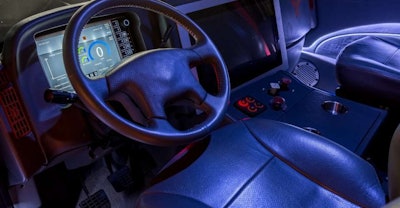 A look at the Thor ET-One cockpit.
A look at the Thor ET-One cockpit.Thor says its battery design “is different in its layout and cooling process to most electric batteries” and is the more energy-dense than any other on the market. So much so, they say, that it is competitive on a short-haul basis with diesel engines in terms of energy efficiency and cost.
With contemporaries like Tesla and Nikola Motor Company targeting the long-haul segment, Sordoni says Thor is content with developing a tractor for regional purposes.
“Thor’s vision,” he says, “is to address the short and medium-haul market.”
By targeting customers who return to base at the end of the day, Thor will rely on the charging capabilities at the fleet-level versus attempting to string together a network of roadside charging stations.
“Most of the folks we’re speaking to in the regional market, less than 300 miles, return to base and would install chargers at their site,” Sordoni says, adding that Thor plans to partner with charging infrastructure companies in the future. “It’s also worth noting the batteries on the ET-One are swappable. Therefore, when approaching over the road applications in the future, there are a few ways Thor would approach that problem. One could be partnerships with existing charging infrastructure companies. Another could be pursuing more of a swapping strategy, which would also make a lot of sense for us.”
